Recently, it has been published Isolario Geographical notes on the work of Barbara De Ponti dedicated to providing a rereading of the work and research of this Milanese artist. Curated by Alessandro Castiglioni, the book contains critical contributions by Matilde Marzotto Caotorta, Ermanno Cristini and Elio Franzini and is published by Postmediabooks. After the presentation at the Milan Triennale, in the conference there are geographies. Artistic practice and geographical research, I met Barbara De Ponti and Alessandro Castiglioni to talk about connections between geography, architecture and art in public space.
In 2011 you started working together with Isolario. A project that is not just a book, an artist’s book or a simple collection of essays. I like to describe it taking up the words of Alessandro, as a “collection of geographical notes” on your artistic practice, Barbara. I would like to start by asking you what were the coordinates from which this work originated and to what needs it responds. But above all, why this title?
This book is on the whole a project of re-reading and analyzing Barbara’s work. It was born as a long dialogue, which still continues today, between the two of us, to which several voices have been added (Matilde Marzotto, Elio Franzini, Ermanno Cristini), as the volume documents. The idea, in the end, was clear: to enhance the procedural component, the research dimension, the investigative position, within the artist’s work, whose main field of study is that of the relationship between man and space. This relationship is studied through the visual and cultural tools of anthropic geography, cultural anthropology, architecture and urban planning. These fields were the common and shared territory in which our dialogue took place and, precisely for this reason, the topics of the book itself or, at least, the keys of reading through which I tried to reconsider the work of Barbara. The book, following this direction, has as its title the word Isolario because it identifies the first sixteenth-century publications that prelude the creation of geographical atlases. They were characterized by a description of the spaces that retained a strong identity of the places, in line with what this work documents, which is not just an atlas, but a collection of geographical notes on the work of Barbara.
A particularity of Isolario concerns its structure, apparently very rigid. To the descriptions on the practice of Barbara at the hands of Alessandro, the reflections of Ermanno Cristini and Elio Franzini alternate and the “glossary” section edited by Matilde Marzotto Caotorta. In particular, in these theoretical focus the author analyzes some key terms related to the work of the artist providing a transversal reading. I find this structure seemingly rigid, because it is a crossroads of trajectories, reflections that combine art with philosophy, literature, history, geography and architecture. I would like to know why you chose to involve these authors, also in relation to your personal projects and why you, Barbara, never take the word directly inside the book.
The book, like the process of my work, has a rigorous and multifaceted structure that proposes a multi-level reading of the theoretical path. For Isolario, which I consider an artistic operation, each author has been invited to try his own language knowing that the contribution would have been a principle for changes in perspective and for in-depth studies both for the other authors and for the readers. To remain consistent with this method, it seemed to me inappropriate to intervene with one of my texts, preferring to document the sources and solicitations from which the process of each of the works considered in the book with Alessandro begins.
Barbara, you bring your artistic work back to the definition of a place used by geography: that is, “a measure united to experience”. In your works you always start from the study of documents and archive images, meticulous and in-depth research that goes on for a long time and allow you to collect data and achieve objective and scientific results. This rational and solitary approach, however, combines experiences with people. I can think of, for example, the work Speaking Things carried out in Delft, in the Netherlands, in 2009. An installative and layering work of practices where, however, the relationship mechanism was the fundamental step. This work reminded me of Nicolas Bourriaud’s theories about relational art and two things I would like to know. How have you activated the relationship processes with the people involved in the project? If you had to define yourself as an artist, would there be a category within which you feel you belong?
The example that you mention, Speaking Thinks, is the project selected for the residence organized by id11 in Delft, based on the relationship between artists and inhabitants of the Dutch city. I was assigned an apartment in a popular building waiting to be shot down for urban redevelopment. Each apartment occupied by an artist was marked by a yellow tinted window. Art is part of the social reality and the inhabitants feel invited to deepen the knowledge of the host and of the project in progress. It was not difficult therefore to involve the population. I asked to bring, to be photographed, the object that represented their relationship with the city. Each image, with the ribbon that describes the choice, was hung on the map drawn on the ceiling, at the address of the owner. The progress of work, the thickening of the network, was the best solicitation for participation.
Each path based on relational dynamics necessarily refers to the thoughts on the practices of some artists of the 90s by Nicolas Bourriaud, and I’m glad it’s no exception mine, but I can not recognize myself in a definition preferring to use, in the same research, different dynamics, autonomous but complementary, as more scientific methods that make use of the same thesis.
The tool of the map is central both in the practice of Barbara and in the theoretical reflections of Isolario. In the “glossary” section, Caotorta reports two significant contributions: from the geographer Franco Farinelli and the writer Italo Calvino. On the one hand Farinelli, alluding to the first table designed by Anaximandro in the sixth century BC, speaks of the map as a representation of a space. On the other hand, Calvino puts the accent on the journey by writing that “the first need to fix places on paper is linked to travel”. In these two definitions the shapes of the drawing and the journey come together and summarize your practice of approaching the places. Can you tell me about the use of the map within your work, hinting also on different projects developed over the years?
Once again I have to start from the terms measure and experience. These are the two natures of the map, as well as the Isolario glossary exemplifies, which by condensing becomes the process of all my research.
I need some examples. Planning Constellation. I have selected from the answers of 300 interviewed thirteen architectures built after World War II in Milan. They became the subjects of thirteen cards that set up gave birth to an emotional map designed by those who live in the city. It is a meticulous data collection and as important as the relational part. The two natures are also present in the evolution of the project. For the creation of the book with Alessandro we decided to undertake the trips that would lead us to the destinations indicated by the interviews for a substantial knowledge of the places revealed only through this experience.
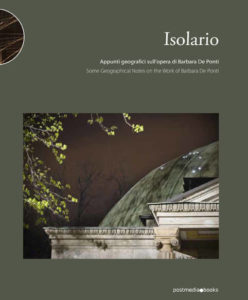 cover Isolario
cover Isolario
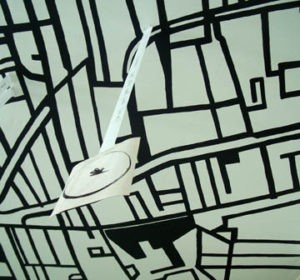 Detail of the ceiling map, Speaking things project, 2009, id11 Flat land, Delft
Detail of the ceiling map, Speaking things project, 2009, id11 Flat land, Delft
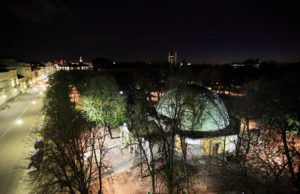 La luce naturale delle stelle, 2010. Planetario Hoepli di Milano, photo V.Roberto
La luce naturale delle stelle, 2010. Planetario Hoepli di Milano, photo V.Roberto
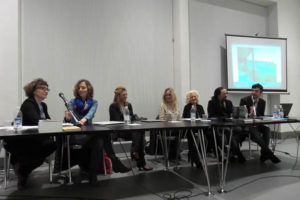 Are There Geographies, Triennale Milano, 19 nov 2014
Are There Geographies, Triennale Milano, 19 nov 2014
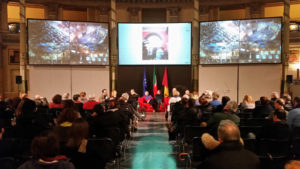 Convegno To Identity, Casa dell’Architettura, Roma, 5 febbraio 2015
Convegno To Identity, Casa dell’Architettura, Roma, 5 febbraio 2015
For Speaking Things, the map has concretely represented the starting point of the project and therefore of contact with the inhabitants. Drawing the urban grid has allowed us to orientate ourselves to all those who wanted to participate in the creation of meetings and events, transforming the two-dimensional static representation into a living place, in the relational performative mat.
The astral map of the project The natural light of the stars, created with the LED lights installed above the outer dome of the planetarium Hoepli, represents the constellations present, but rarely visible from the city, in the sky of Milan on the day of the 2010 Spring Equinox. The symbolic form of the constellations is such only for the community that has constituted it and one recognizes oneself as belonging to the same language.
The thing that struck me most, of your work, is that you always go in search of places or stories often unknown or on the margins. I come to mind The natural light of the work stars conceived for the 2010 Hoepli Planetarium in Milan or Route to Identity realized in the former Roman Aquarium between 2012 and 2013. Your is a decentralized look and oriented towards specific architectures of the city. Can you tell me why your choice falls on these stories and on these places? How do you insert yourself into the debate, still ongoing, on the relationship between centrality and the periphery?
The Rome aquarium and the Milan planetarium were examples of technical and scientific excellence in the years of their establishment. The innovative and visionary thinking of those who conceived these institutes has not found an easy response in their historical and social context, which relegates them to a marginal role compared to that for which they had been imagined, even coming to definitively change their function. The reasons that lead to these evolutions of identity have made me deepen the history of these buildings and today, thanks to the interest that many find in the investigation that can be done within them, slowly regain centrality as shown by the exhibition and the conference on my To Identity project produced and hosted by the Order of Architects of Rome and Lazio.
Alessandro, in November last year you curated at the Triennale di Milano the conference Are there geographies. Artistic practice and geographical research. Starting from the work developed with Barbara in Isolario, you have invited several speakers as well: Pier Paolo Coro and Rita Canarezza of Little Costellation, Una Szeemann, Nataša Bodrožić and Ivana Meštrov. The choice of uniting these voices together has depended on their common gaze orientation, towards those places you referred to as “symbolic high definition”. In light of the different experiences mentioned, could you give an explanation, also in relation to the places where Barbara works?
The idea of the conference Are There Geographies? it is that of a complex curatorial project, solved in the dialogical form of a seminar open to the public. For several years now I have been dealing with investigations that touch on issues and topics of a geographical nature, in particular taking care of the network of Little Constellation, a project by Rita Canarezza and Pier Paolo Coro dedicated to contemporary art in the small states and in the geo-political micro-areas of Europe. It is from this experience and from the essential contribution of a person that has been for me a constant reference, Roberto Daolio, that comes the definition (elaborated by Pier Paolo Coro) of which you ask me and which covers all those areas or situations or, again, those occasions in which the symbolic dimension of a place exceeds its physical or geopolitical importance. This sensitivity to deep aspects, typical of the identity of the places, has become a sort of characteristic that has been able to put in dialogue this network with the work of Barbara and with other authors or theorists with whom I have been able to work as for example Natasa and Ivana with whom (along with others) I curated Mediterranea 16th XVI Biennial of Young Artists of Europe and the Mediterranean in 2013. The project could, in fact, become many things: an exhibition, a further publication, but the idea was that of a live and real confrontation, so the conference was born.
Michela Lupieri (* 1983) is curator, researcher and author. She graduated at IUAV of Venice in Visual Arts, with a specialization in contemporary art and curatorial practices. She is part of the curatorial team of Palinsesti and research fellow at the Archive of the Avant-gardes (Collezione Marzona) at the SKD of Dresden. She lives between Italy and Germany.


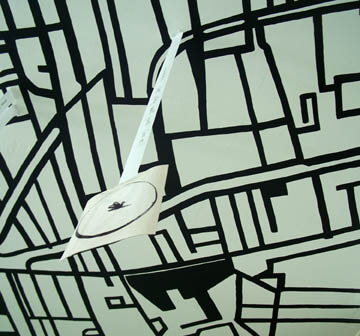


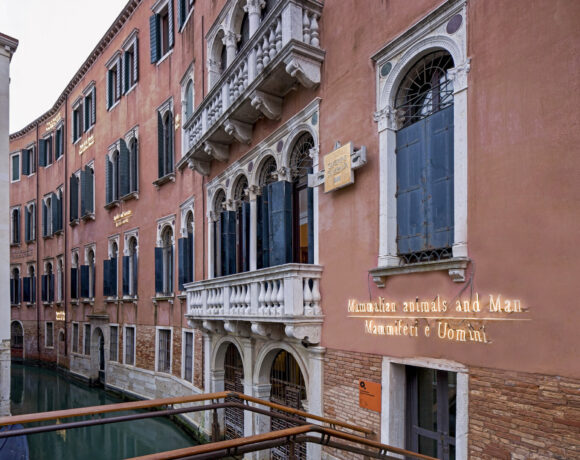

NO COMMENT